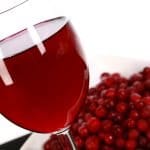Partridgeberry Wine
Homemade Partridgeberry Wine (AKA: Lingonberry Wine) is fantastic, and worth the bit of effort to make it. Here’s how!
Servings: 5 Gallons
Calories: 6560kcal
Equipment
- 1 6.5 gallon fermenter bucket and lid
- 1 or 2 6.5 gallon glass carboys & stoppers
- 1 air lock and stopper
- Siphon, siphon tubing.
Ingredients
- 15 lbs Frozen Partridgeberries
- 13 lbs Granulated Sugar
- 5 gallons Water
- 2.5 teaspoon Acid Blend
- 2.5 teaspoon Pectic Enzyme
- 1 teaspoon Yeast Nutrient
- 5 lbs Golden Raisins
- 1.25 teaspoon Wine Tannin
- 1 package Red Star Montrechet Wine Yeast
Instructions
- Allow the partridgeberries to partially thaw, then coarsely chop them (A food processor comes in handy!).
- Place berries and sugar into a large (7+ gallon) pot, stir until well combined. Add water, stir well to dissolve sugar. Heat to ALMOST boiling – stirring constantly – then simmer gently for 10 minutes.
- Stir in acid blend, enzyme, nutrient, and raisins.
- Pour mixture into a freshly sanitized 6.5 gallon fermenting bucket. Cover with sanitized lid and air lock, allow to cool to room temperature (overnight).
- The next morning, give the mixture a quick stir with a long, sanitized spoon, and – using sanitized equipment – take a gravity reading. Keep track of the number! (This is an optional step, but will allow you to calculate your final ABV %)
- Sprinkle yeast into fermenter, cover with sanitized cover and air lock. Within 48 hours, you should notice fermentation activity – bubbles in the airlock, carbonation and /or swirling in the wine must. This means you’re good to go!
- After a week or so, use your sanitized siphon setup to rack the must into a freshly sanitized 6- 6.5 gallon carboy. Put the carboy somewhere cool (not cold!), and leave it alone for a month or so.
- Using sanitized equipment, rack the partridgeberry wine off the sediment, into a clean, freshly sanitized 5 or 6 gallon carboy. Cap with sanitized airlock, leave it alone for another 2-3 months.
- Rack one more time, leave it for another 3 months or so.
- When your wine has been racked a few times and shows NO more fermenting activity for a month or so (no bubbles in the airlock, no more sediment being produced, you can move on to bottling.
- Follow the instructions on your selected type of wine stabilizer to stop fermentation. For potassium sorbate, this needs to be done 2-3 days before bottling.
- Using sanitized equipment, take a gravity reading, then rack the wine into clean, sanitized bottles. Cork.
- Store wine in a cool dark place. Wine tastes even better after a year of aging in bottles.
Notes
IMPORTANT:
Software generates nutritional information based on the ingredients as they start, and is unable to account for the sugars consumed in the fermentation process. As such, the calories, sugars, and carbs are shown WAY higher than reality.
Additionally, the listed value is for the entire recipe, NOT per serving.
Nutrition
Calories: 6560kcal | Carbohydrates: 1706g | Protein: 21g | Fat: 4g | Saturated Fat: 1g | Sodium: 283mg | Potassium: 4564mg | Fiber: 81g | Sugar: 1500g | Vitamin A: 816IU | Vitamin C: 195mg | Calcium: 475mg | Iron: 12mg
